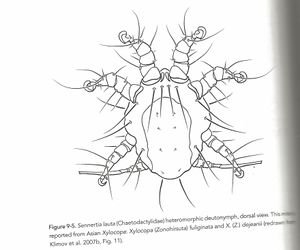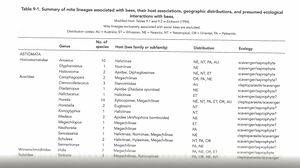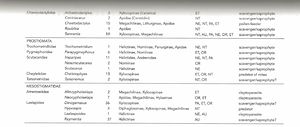Brood Cell Microcosm: Difference between revisions
| Line 20: | Line 20: | ||
Most studies of microbial associates living inside the | Most studies of microbial associates living inside the food provision of wasp brood cells come from work done on the non-solitary bee species such as honey or bumblebees. Early research was done using culture-based techniques by Gilliam et al. in 1984 and 1989 that demonstrated spore-forming bacteria in the genus ''Baccilus'' are not only found in the pollen provisions of social honeybee and bumblebee colonies, but also in 3 species of '''solitary bees''' spanning across 2 different families (Apidae and Colletidae). This genus of bacteria is known to produce enzymes that are used by honey bees as microbial agents in their pollen and nectar provisions. Gilliam states: "The production of both antibiotics and fatty acids by Bacillus spp. in larval provisions could limit the types of microbes that are able to survive, inhibit competition by other microbes for this food source, and protect the food from spoilage." | ||
Recent work using modern techniques such as metagenomic sequencing has revealed other bacterial species such as ''Burkolderia'' | Recent work using modern techniques such as metagenomic sequencing has revealed other bacterial species such as ''Burkolderia sp.'' ubiquitously inhabit the midgut of most bee families and some families of the closely related apoid wasps. This bacteria may be an important member of the digestive tract microbiota of solitary bee and wasp species and may be transferred into pollen provisions that are eaten by larvae. | ||
Other species of bacteria such as the American and European foulbrood ('' Paenicacillus larvae'' and ''Melissococcus plutonius'' respectively) cause serious disease in honeybees colonies. Bacterial-borne pathogens that affect wild solitary bees are largely unknown and need to be researched with more depth. | Other species of bacteria such as the American and European foulbrood ('' Paenicacillus larvae'' and ''Melissococcus plutonius'' respectively) cause serious disease in honeybees colonies. Bacterial-borne pathogens that affect wild solitary bees are largely unknown and need to be researched with more depth. | ||
Revision as of 18:47, 14 April 2021
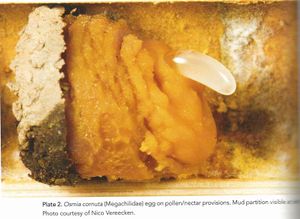
The nests of solitary wasp species (including everybody's favorite pollen-collecting solitary wasps "the bees") are known as brood cells. Depending on the species observed these cells can be found in underground chambers, hollow twigs, sculpted with mud, or even crammed inside abandoned snail shells. These cells that female wasps provision with a food source (prey or pollen) and lay an egg in, don't stop interacting with the environment once they are sealed. The microcosm formed when a mother wasp seals a finished brood cell is home to a plethora of co-evolved relationships that can beneficially or negatively affect the health of the egg/larvae found in the nest. Brood cell mutualists and parasites span across many taxa; from yeasts and bacteria that negatively affect the health of the occupant, all of the way to mutualistic prostigmatic mites that fend off/eat infectious fungi.
Solitary Wasp Life Cycle and Development:
Solitary wasps are any of the Aculeate Hymenoptera that are not social, meaning they don't have a reproductive division of labor with queens laying eggs and workers.. working. Instead, female individuals create their own nests (broods) and provision these nests with a food source on their own. The food sources that each species of solitary wasps collect are highly variable. Some individual species or groups of closely related species can be extremely specialized to one type of food item. Examples of this are the clade Anthophila (the bees) which all provision their brood cells exclusively with pollen, or the family Pompilidae (the spider wasps) which only provision their nests with spiders. Once a brood cell is provisioned to perfection the solitary wasp mother will lay a single egg and seal the cell. She will build and provision brood cells until she dies. The eggs laid will hatch into larvae and begin to eat the food provision and grow. Larvae of many species undergo a period of diapause during the winter months before they pupate and exit as adults in the spring/summer. The focus of this page will take place in the part of the life cycle after the mother wasp seals her preciously provisioned cell and before her offspring emerges the following year.
Members of Brood Cell Microcosm:
This section is a brief window into the understudied diversity of the solitary bee brood cell. There are many non-bee solitary wasp brood cell associates but most study has been placed on the economically important bee species.
Bacteria:
Most studies of microbial associates living inside the food provision of wasp brood cells come from work done on the non-solitary bee species such as honey or bumblebees. Early research was done using culture-based techniques by Gilliam et al. in 1984 and 1989 that demonstrated spore-forming bacteria in the genus Baccilus are not only found in the pollen provisions of social honeybee and bumblebee colonies, but also in 3 species of solitary bees spanning across 2 different families (Apidae and Colletidae). This genus of bacteria is known to produce enzymes that are used by honey bees as microbial agents in their pollen and nectar provisions. Gilliam states: "The production of both antibiotics and fatty acids by Bacillus spp. in larval provisions could limit the types of microbes that are able to survive, inhibit competition by other microbes for this food source, and protect the food from spoilage."
Recent work using modern techniques such as metagenomic sequencing has revealed other bacterial species such as Burkolderia sp. ubiquitously inhabit the midgut of most bee families and some families of the closely related apoid wasps. This bacteria may be an important member of the digestive tract microbiota of solitary bee and wasp species and may be transferred into pollen provisions that are eaten by larvae.
Other species of bacteria such as the American and European foulbrood ( Paenicacillus larvae and Melissococcus plutonius respectively) cause serious disease in honeybees colonies. Bacterial-borne pathogens that affect wild solitary bees are largely unknown and need to be researched with more depth.
More research is needed on all fronts to determine the microbial diversity found associated with solitary bee and wasp brood cells to determine what roles they play in solitary bee and wasp community ecology.
Fungi:

Studies have shown that there are a diversity of fungi and yeasts that play important beneficial, negative, and possibly commensal roles in the microcosm of solitary bee and wasp brood cells.
Nematodes:
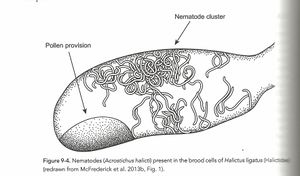
Mites:
